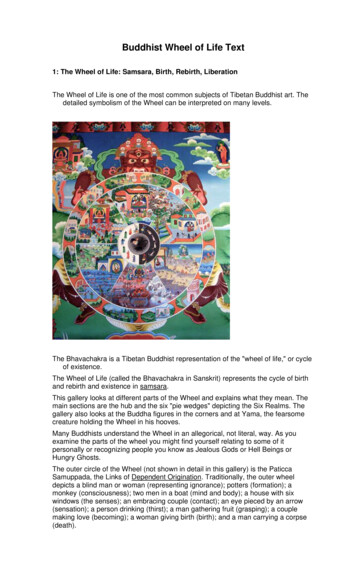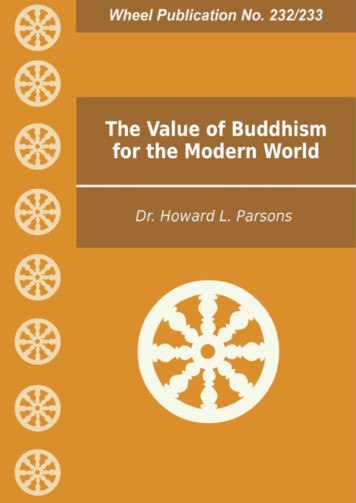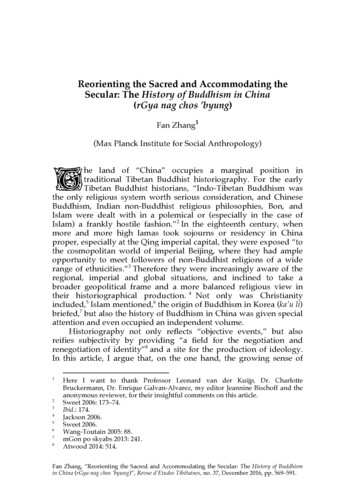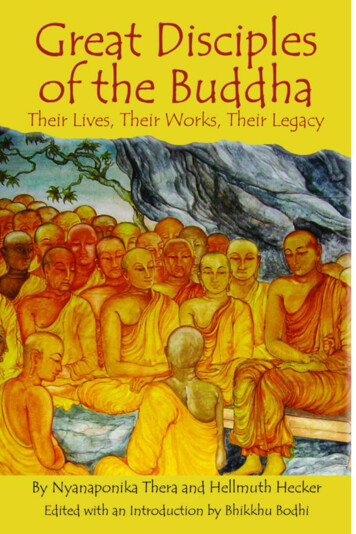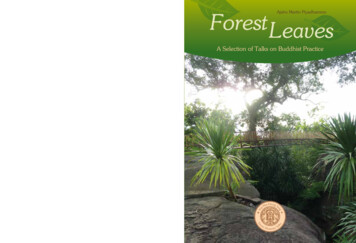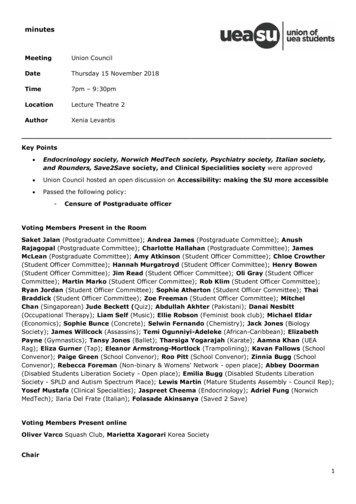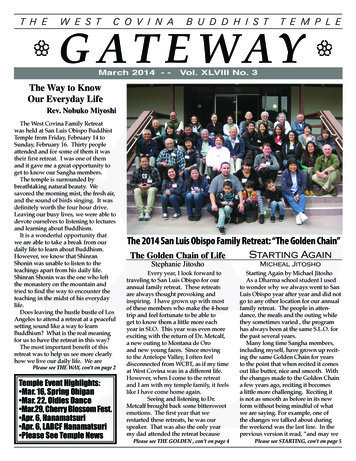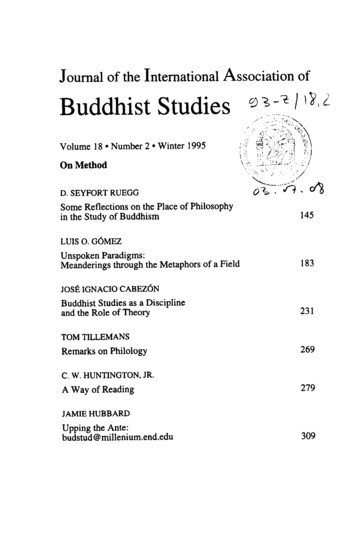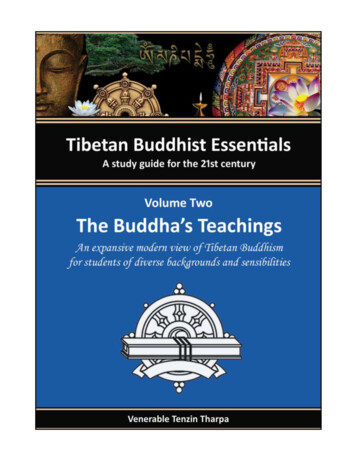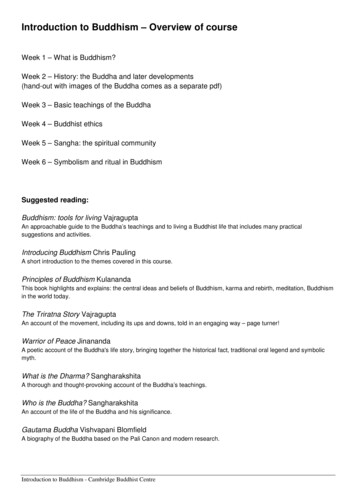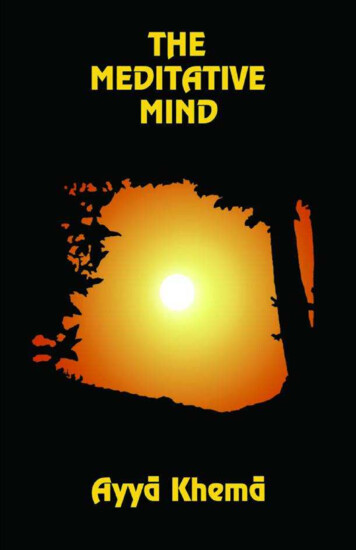
Transcription
THE MEDITATIVE MINDTen Dhamma Talks from aMeditation RetreatHeld in 1987 in Sri LankabySister Ayyá Khemá
Buddhist Publication SocietyP.O. Box 6154 Sangharaja MawathaKandy, Sri Lankahttp://www.bps.lkCopyright 1989 Sister Ayyá KhemáFirst edition, called To Be Seen Here and Now, 1989First BPS edition: 2012Republished with the kind permission of Jhana VerlagNational Library and Documentation Services Board Cataloguing-In-Publication DataBhikshuni Ayyá Khema,The Meditative Mind: Ten Dhamma Talks from aMeditation Retreat held in 1987 in Sri Lanka /Bhikshuni Ayyá Khemá: ed. by BhikkhuNyanatusita - Kandy: Buddhist Publication SocietyInc., 2012BP 523s.- 116p.; 18.5cmISBN 978-955-24-0385-9i. 294.34435 DDC 23iii. Bhikkhu Nyanatusita ed.1. Meditation - BuddhismISBN: 978-955-24-0385-9Printed byCreative Printers & Designers,Bahirawakanda, Kandy.ii. Title
ContentsPreface . 4I. The Meditative Mind . 5II. Skilful Means . 17III. Awake and Aware . 28IV. Supreme Efforts . 38V. Expanded Consciousness . 47VI. Kamma is Intention . 60VII. Spiritual Faculties . 72VIII. Steps on the Way . 82IX. Pathways to Power . 92X. Making the Most of Each Day . 100Glossary . 111
PrefaceMeditation retreats are a time for introspection.Because they are held in silence, except for Dhammatalks and questions, the mind becomes more and moreused to mindfulness and concentration. This givesadded impetus to the hearing of Dhamma, so that thetruth of the Buddha’s teaching can leave a lastingimpression.When you open this book, dear reader, maybe youcould imagine being in a meditation retreat, wherenothing else matters except the clarity andwholesomeness of your own mind. This means leavingall daily preoccupations aside and focusing strictly onthe wonderful freedom the Buddha’s teaching andpractice can provide. May you enjoy the followingpages and find something useful in them.Sister Ayyá KhemáParappuduwa Nuns’ Island,Dodanduwa,Sri Lanka.December 31st, 1989
I. The Meditative Mindeople are often surprised how difficult it is toP meditate. Outwardly it seems to be such a simplematter to just sit down on a little pillow and watch one’sbreath. What could be hard about that? The difficultylies in the fact that one’s whole being is totallyunprepared. Our mind, senses, and feelings are used totrade in the market place, namely the world in whichwe live, but meditation cannot be done in a marketplace; that is impossible. There is nothing to buy ortrade or arrange in meditation, but most people’sattitude remains the same as usual and that just doesnot work.We need patience with ourselves. It takes time tochange to the point where meditation is actually a stateof mind, available at any time because the market placeis no longer important. The market place does not justmean going shopping. It means everything that is donein the world: all the connections, ideas, hopes andmemories, all the rejections and resistances, all ourreactions.In meditation we may have momentary glimpsesof concentration (samádhi), but they cannot besustained and our mind slips off and goes right back towhere it came from. In order to counteract that, wehave to have determination to make our life ameditative one. This does not mean we have tomeditate from morning till night—I do not knowanyone who does so. It does not mean we cannot fulfilour duties and obligations, because they are necessary
6THE MEDITATIVE MINDand take priority as long as we have them. It means thatwe watch ourselves carefully in all our actions andreactions to make sure that everything happens in thelight of the Dhamma—the Truth. This applies to thesmallest detail such as our food and what we listen toor talk about. Only then can the mind be ready with ameditative quality when we sit down on the cushion. Itmeans that no matter where we find ourselves, weremain introspective. That does not mean we cannottalk to others, but we watch the content of thediscussion.That is not easy to do and the mind often slips offbut we can become aware of the slip. If we are not evenaware that we have digressed from mindfulness andinner watchfulness, we are not on the meditative pathyet. If our mind has the Dhamma quality establishedwithin, then meditation has a good chance.The more we know of the Dhamma, the more wecan watch whether we comply with its guidelines.There is no blame attached to our inability to do so, butthe least we can do is to know the guidelines and knowwhere we are making mistakes. Then we practise to getnearer and nearer to absolute reality, until one day wewill actually be the Dhamma.There is this difference between one who knowsand one who practises. The one who knows mayunderstand the words and concepts, but the one whopractises knows only one thing, namely, to become thattruth. Words are an utilitarian means not only forcommunication, but also to solidify ideas. That is whywords can never reveal the truth, only personalexperience can. We attain our experiences through
THE MEDITATIVE MIND7realising what’s happening within and why it is as it is.This means that we combine watchfulness with inquiryas to why we are thinking, saying and reacting the waywe do. Unless we use our mind in this way, meditationwill be an on-again, off-again affair and will remaindifficult. When meditation does not bring joy, mostpeople are quite happy to forget about it.Without the meditative mind and experience, theDhamma cannot arise in the heart, because theDhamma is not in words. The Buddha was able toverbalise his inner experience for our benefit, to give usa guideline. That means we can find a direction, but wehave to do the travelling ourselves.To have a meditative mind, we need to developsome important inner qualities. We already have theirseed within otherwise we couldn’t cultivate them. If wewant flowers in our garden and there are no seeds, wecan water and fertilise, yet nothing will grow. Thewatering and fertilising of the mind is done inmeditation. Weeding has to be done in daily living.Weeds always seem to grow better in any garden thanthe flowers do. It takes a lot of strength to uproot thoseweeds, but it is not so difficult to cut them down. Asthey get cut down again and again, they eventuallybecome feeble and their uprooting is made easier.Cutting down and uprooting the weeds needssufficient introspection into ourselves to know what aweed is and what is a flower. We have to be very sure,because we do not want to pull out all the flowers andleave all the weeds. A garden with many weeds is notmuch of an ornament.
8THE MEDITATIVE MINDPeople’s hearts and minds usually contain equalamounts of flowers and weeds. We are born with thethree roots of evil: greed, hate and delusion, and thethree roots of good: generosity, loving-kindness andwisdom. Does not it make sense to try and get rid ofthose three roots which are the generators of allproblems, all our unpleasant experiences andreactions?If we want to eliminate those three roots, we haveto look at their manifestations. Roots are underneaththe surface, but obviously a root sprouts and showsitself above the surface as a weed. We can see thatwithin ourselves. Caused by delusion, we manifestgreed and hate. There are different facets of greed andhate, and the simplest and most common one is “I like,”“I want,” “I do not like,” and “I do not want.” Mostpeople think such reactions are perfectly justified, andyet it is greed and hate. Our roots have sprouted in somany different ways that we have all sorts of weedsgrowing. In a garden we will find possibly thirty orforty different types of weeds. We might have thatmany or more unwholesome thoughts and emotions.They have different appearances and power but theyare all coming from the same roots. As we cannot get atthe roots yet, we have to deal with what is above thesurface. When we cultivate the good roots, they becomeso mighty and strong that the weeds do not findenough nourishment any more. As long as we allowroom for the weeds in our garden, we take the nutrientsaway from the beautiful plants, instead of cultivatingthose more and more. This cultivation of good innerqualities takes place as a development in daily living,
THE MEDITATIVE MIND9which then makes it possible to meditate as a naturaloutcome of our state of mind.Now we are trying to change our mind from anordinary one to a meditative one, which is difficult ifone has not practised very much yet. We only have onemind and carry that around with us to every activityand also to the meditation. If we have an inkling thatmeditation can bring us peace and happiness, then weneed to make sure we have a meditative mind alreadywhen we sit down. To change it from busyness to quietat that moment is too difficult.The state of mind which we need to develop formeditation is well described by the Buddha. Twoaspects of importance are mindfulness (sati) and thecalming of the senses. Internal mindfulness maysometimes be exchanged for external mindfulnessbecause under some circumstances that is an essentialpart of practice. The world impinges upon us, which wecannot deny.External mindfulness also means to see a tree, forinstance, in a completely new way. Not with the usualthoughts of “that is pretty,” or “I like this one in mygarden,” but rather noticing that there are live anddead leaves, that there are growing plants, mature onesand dying ones. We can witness the growth, birth anddecay all around us. We can understand craving veryclearly by watching ants, mosquitoes, dogs. We neednot look at them as a nuisance, but as teachers. Ants,mosquitoes and barking dogs are the kind of teacherswho do not leave us alone until the lessons are fullylearned. When we see all in the light of birth, decay,death, greed, hate and delusion, we are looking in a
10THE MEDITATIVE MINDmirror of all life around us; then we have Dhamma onshow. All of us are proclaiming the truth of Dhammaconstantly, only we do not pay enough attention.We can use mindfulness to observe thateverything in existence consists of the four elements,earth, fire, water, air; and then check out what is thedifference between ourselves and all else. When wetake practice seriously and look at all life in such a way,then we find the truth all around as well as within us.Nothing else exists.This gives us the ability to leave the marketplacebehind where the mind flits from one thing to the next,never has a moment’s peace, is either dull andindifferent or hateful and greedy. But when we look atthat which really is, we are drawing nearer to what theBuddha taught, out of his compassion for all the beingsthat are roaming around in samsara from one state ofunsatisfactoriness or suffering (dukkha) to the next. Hetaught the truth of Dhamma so that people like us mayawaken to it.We should neither believe nor disbelieve what wehear or read, but try it out ourselves. If we give ourwholehearted attention to this practice, we will findthat it changes our approach to living and dying.Wholeheartedness is necessary to succeed in anythingwe do. If we get married and are half-hearted about it,that cannot be very successful. Half-hearted practice ofDhamma results in chaotic misunderstanding. Wholeheartedness may have at its core devotion, and a mindwhich goes beyond everyday thoughts and activities.Another facet which goes together withmindfulness (sati) is clear comprehension (sampajañña).
THE MEDITATIVE MIND11Mindfulness is to be aware only, without anydiscriminating faculty. Mindfulness does not evaluateor judge but pays full attention. Clear comprehensionhas four aspects or steps to it. The first is, “What is mypurpose in thinking, talking or doing?” Thought,speech and action are our three doors. The second is,“Am I using the most skilful means for my purpose?”That needs wisdom and discrimination. The third is,“Are these means within the Dhamma?” It is necessaryto know the distinction between the wholesome andthe unwholesome. The thought process needs ourprimary attention, because speech and action willfollow from it. Sometimes people think that the endjustifies the means. It does not. Both means and endhave to be within the Dhamma. The fourth step is tocheck whether our purpose has been accomplished,and if not, why not.If we live with these steps in mind, we will slowdown, which is helpful for our reactions. I do notsuggest inactivity, that is not the answer, but tomaintain the meditative quality of the mind, whichwatches over what we are doing. When we usemindfulness and clear comprehension, we have to givetime to investigate. Checking prevents mistakes.Our wrong thinking creates the danger of makingbad kamma and takes us away from the truth intonebulous mind-states. The Dhamma is straightforward, simple and pure. It needs a pure mind to staywith it. Otherwise we find ourselves outside of it againand again.External mindfulness can also extend to otherpeople, but here we need to be very careful. Seeing and
12THE MEDITATIVE MINDknowing others engenders negative judgment. If wepractise external mindfulness towards other people, wehave to realise that judging others is making badkamma. We can pay attention with compassion.People-watching is one of the most popular pastimesbut usually done with the intention of finding fault.Everyone who is not enlightened has faults; even thehighly developed non-returner (anágámi) has yet fivefetters to lose. What to say about ordinary worldlings?To use other people as our mirror is very helpfulbecause they reflect our own being. We can only see inothers what we already know about ourselves. The restis lost to us.If we add clear comprehension to our mindfulnessand check our purpose and skilful means we willeliminate much grief and worry. We will develop anawareness which will make every day, every momentan adventure. Most people feel bogged down andburdened. Either they have too much or too little to do;not enough money to do what they like or theyfrantically move about trying to occupy themselves.Everybody wants to escape from unsatisfactoryconditions, but the escape mechanism that each onechooses does not provide real inner joy. However withmindfulness and clear comprehension, just watching atree is fascinating. It brings a new dimension to our life,a buoyancy of mind, enabling us to grasp wholeness,instead of the limitations of our family, job, hopes anddreams. That way we can expand, because we arefascinated with what we see around and within us, andwant to explore further. We do not watch “my” mind,“my” body, “my” tree, but watch just phenomena all
THE MEDITATIVE MIND13around us that provide us with the most fascinating,challenging schoolroom that anybody could ever find.Our interest in the schoolroom increases asmindfulness increases.To develop a meditative mind, we also need tocalm our senses. We do not have to deny ourselvessensory experiences, that would be foolishness, but seethem for what they are. Mára the tempter is not a fellowwith a long tail and a flaming red tongue, but ratherour senses. We hardly ever pay attention to what theydo to us when they pull us from an interesting sight toa beautiful sound, and back to the sight, the thought,the idea. No Peace! Our constant endeavour is to catcha moment’s pleasure.A sense contact has to be very fleeting, becauseotherwise it becomes a great dukkha. Let’s say we areoffered a very nice meal, which tastes extremely good.So we say to our host: “That is a very nice meal, I like itvery much.” The host replies: “I have lots of food here,please stay around and eat for another two or threehours.” If we did, we would not only get sick in bodybut also disgusted in our mind. A meal can last twentyor at the most thirty minutes. Each taste contact canonly last a second and then we have to chew andswallow. If we were to keep it in the mouth any longer,it would become very unpleasant.Maybe we feel very hot and go to take a coldshower. We say to our friend waiting outside: “Now Ifeel good, that cold water is very pleasant.” Our friendsays, “We have plenty of cold water, you can have ashower for the next five to six hours.” Nothing but
14THE MEDITATIVE MINDabsolute misery would result. We can enjoy a coldshower for ten or twenty minutes at the most.Anything that is prolonged will create dukkha.All contacts pass quickly, because that is their nature.The same goes for sight, our eyes are continuallyblinking. We cannot even keep sight constant for thelength of time we are looking at anything. We may belooking at a beautiful painting for a little while andreally like it. Someone says: “You can stay here andlook at the painting for the next five hours; we are notclosing the museum yet.” Nobody could do that. Wecannot look at the same thing a long time, withoutfeeling bored, losing all awareness, or even fallingasleep. Sense contacts are not only limited because oftheir inability to give satisfaction. They are actuallywaves that come and go. If we are listening to somelovely music, after a few hours the same music becomesunbearable. Our sense contacts are mirroring areflection of satisfaction, which has no real basis in fact.That is Mára constantly leading us astray.There is a pertinent story of a monk in theBuddha’s time which relates the ultimate in sensediscipline: A married couple had a big row and thewoman decided to run away. She put on her best sari,wore all her gold jewellery and left to go to herrelatives. On the way she saw a monk walking on thestreet, at whom she laughed. The monk looked up andonly saw her teeth. After a while the husband wassorry that he had let her go and followed her. He ranhere and there, but couldn’t find her. Finally he cameacross the monk. He asked the monk if he’d seen awoman in a red sari with long black hair and lots of
THE MEDITATIVE MIND15jewellery. The monk said: “I only saw a set of teethgoing by.”The monk was not paying attention to theconcepts of a woman with long black hair, a red sari,and lots of jewellery, but only to the fact that there wasa human being with a set of teeth. He had calmed hissenses to the point where the sight object was no longertempting him into a reaction. An ordinary person atthe sight of a beautiful woman with black hair, a redsari and lots of jewellery, going excitedly along thestreet, might have been tempted to follow her. A set ofteeth going by, is highly unlikely to create desire. Thatway of paying attention is calming the senses.If we come upon a snake, it is not an object ofdislike or destruction, but just a sentient being thathappens to be around. That is all. There is nothing to bedone, nothing to react to. If we think of it as a snake thatcould kill us, then of course, the mind can go berserk,just as the monk’s mind could have done, if he hadthought “Oh, what a beautiful woman.”If we watch our senses again and again, thisbecomes a habit, and is no longer difficult. Life will bemuch more peaceful. The world as we know it consistsof so much proliferation (papañca). Everywhere aredifferent colours, shapes, beings and nature’s growth.Each family of tree has hundreds of species and subspecies. Nature proliferates. All of us look different. Ifwe do not guard our senses, this proliferation in theworld will keep us attracted life after life. There is toomuch to see, do, know and react to. Since there is noend to all of that we might as well stop and delve insideof ourselves.
16THE MEDITATIVE MINDA meditative mind is achieved through mindfulness, clear comprehension and calming the senses.These three aspects of practice need to be done ineveryday life. Peace and harmony will result, and ourmeditation will flourish.
II. Skilful Meanshe two aspects of our being are mind and body.We have to pay attention to both of them, evenTthough meditation is a mind exercise, not a bodyexercise.Some of the most common questions are: “Howam I going to learn to sit?” “How am I not going tohave any pain?” That is only possible throughcontinued application, doing it again and again. In thebeginning, the body just does not like sitting crosslegged on the floor.We can use this situation as skilful means. Whendiscomfort arises in the body, we learn to pay attentionto the mind’s reaction, and do not move automatically.Everybody in the world is trying to get out of any kindof discomfort with an instinctive, immediate reaction. Itis not that we are not going to get out of discomfort, butin order to make meditation pay off, we have to learn toget out of instinctive, immediate reactions. It is thosethat land us in dukkha over and over again.When there is an uncomfortable feeling, it isessential to realise what is happening within. We noticethat there is a sense contact, in this case “touch!” Thebody is making contact, the knees with the cushion, thelegs with each other—several contacts are happening.From all sense contacts, feelings arise. There is no wayout of that, this is how human beings are made. TheBuddha taught cause and effect, that dependent uponany sense contact, feeling results. There are three kindsof feelings, pleasant, unpleasant and neutral. We can
18THE MEDITATIVE MINDforget about the neutral ones, because we are hardlyever aware of them. Neutral is actually consideredpleasant, because at least it does not hurt. From thisparticular touch contact that is being made through thesitting posture, there arises, after a while, an unpleasantfeeling. The immediate reaction is to move. Do not!Investigate! By getting to know our own mind, we getto know the world and the universe. All minds containthe seed of enlightenment. Unless we know our ownmind, we cannot develop and cultivate that seed. Herethe mind has been contacted with an unpleasantfeeling, our perception says: “this is painful.” Nextarise the mental formations (saòkhára), which are alsokamma formations, because we make kamma throughour thought processes.First comes the sense contact, secondly feelingarises. Then perception, the naming of this feeling ,followed by dislike. At the moment of dislike, there isthe running away through changing our position. Thatis the kamma making aspect. This is minor negativekamma, yet it is negative, because the mind is in a stateof ill will by saying “I do not like it.”The mind may start all kinds of rationalisations: “Iwish I’d brought my own little chair”; “I cannot sit”;“At my age I shouldn’t do things like this”; “Meditationis too difficult.” None of these rationalisations have anyintrinsic validity; they are only a mind reacting to anunpleasant feeling. Unless we become acquainted withour mind’s reactions, we are not using meditation in themost beneficial manner.Knowing the unpleasant feeling, we can now tryto acquaint ourselves with its true nature. Our whole
SKILFUL MEANS19life is lived according to our feelings. Unless we becomeaware of our reactions to feelings, we remain halfasleep. There is a beautiful little book on this by ThichNhat Han called The Miracle of Being Awake.1 Thismiracle is nothing but mindfulness, knowing what’sgoing on within. When we have realised we want to getrid of the unpleasant feeling, then we can try to disownit for a moment. Only the Arahant is fully capable ofcomplete detachment, but we can do so for a shorttime. The unpleasant feeling has arisen without ourasking for it and we do not have to believe it to be ours.We can let it be just a feeling.If we do that for a moment, we can get back to themeditation subject (kammaþþhána), and have won avictory over our own negative reactions. Otherwise weare letting our unpleasant feelings rule us in whateverway they want. The whole of humanity runs afterpleasant feelings, and away from unpleasant ones.Unless we at least know that, we have no reference pointfor inner change. It may not be possible to reverse thatreaction yet, but at least we know it is happening.After we have become aware of our mind’sintention, we are free to move and change our sittingposition. There is nothing wrong with changing one’sposture but there is something wrong with instinctive,impetuous habits. Meditation means total awareness.Being awake is not the opposite of being asleep; it is theopposite of being dull and foggy. Such mind states aremostly due to an unwillingness to look at ourown dukkha. We’d rather hide in a fog. In meditation1. The Wheel Publication Nos. 234–236; BPS, Kandy.
20THE MEDITATIVE MINDthat won’t do. The Buddha said that this body is acancer; the body as a whole is a disease, and we canexperience that when just sitting still, it becomesuncomfortable.Meditation means samatha and vipassaná, calm andinsight. Unless we know the limitations of each and alsotheir possibilities, we won’t be able to make good use ofthe practice. We are generally applying both of them inevery session, but we must be able to distinguishbetween them. If there is no understanding of what’shappening in the mind, the fog settles down in it.Everybody would like bliss, peace and happiness.That is a natural wish. They are available in meditation,with a lot of practice, and some good kamma. Howeverthey are not the goal of meditation. The goal ofmeditation is insight. Yet skilful means for gaininginsight are needed and are found in tranquillitymeditation.Making use of a meditation subject, the mind, aftersome training, will be able to stay on it for a while.Presuming that the mind is able to focus on the breathfor even a short time, we realise afterwards that somepeace arose, because the mind was not thinking. Thethinking process in everybody’s mind is hardly everprofound. It is just thinking. Just as the body breathes, sothe mind keeps churning. And it keeps churning outmostly irrelevant, unsubstantial and unimportantdetails, without which we would be much happier.The mind in its natural state is pure, clear andlucid, luminous, pliable and expandable. Our thinkingis the impurity and the blockage. There is hardly aperson who does not think all day long, probably
SKILFUL MEANS21without even being aware of it. But when we startmeditating, we do become aware of our innerrestlessness. We realise we cannot keep the mind on themeditation subject, because we are thinking instead ofmeditating. The moment we experience our thinkinghabit (even that takes time to realise) we accomplishtwo things. We become aware of our mind’s activity andalso the content of our thoughts. We will realiseimmediately that our thinking is irrelevant and makeslittle or no sense. Because of that, we can let go of itfairly easily and return to the meditation subject. Wehave to be able to stand back and watch the thinkingprocess and not get involved in it. Otherwise we willjust keep on thinking instead of meditating.The mind is the greatest and most delicate toolexisting in the universe. All of us have it, but few lookafter it properly. Practically everybody is interested inlooking after their bodies. Eating, sleeping, washing,exercising, seeing the doctor when the body is sick,cutting our hair and nails, filling teeth, doing everythingthat is necessary to keep the body functioning well. Inreality, the body is the servant and the mind is themaster. So we are looking after the servant andforgetting the master. If we do that in our homes, wecreate chaos. That is one of the reasons why the worldlooks as chaotic as it does. People kill each other, stealfrom each other and are unfaithful, lie, gossip andslander. Most have absolutely no ideas that the mind isour most precious asset. It gives us wealth beyondcompare and yet we do not know how to look after it.We have to do exactly the same thing for the mindas we do for the body. We need to give it a rest. Imagine
22THE MEDITATIVE MINDif we didn’t go to sleep for three or four days, howwould we feel? Without energy, without strength,pretty terrible. The body needs a rest, but the minddoes too. During the day it thinks, at night it dreams. Itis always busy. The only real rest it can ever get, whichenergises and gives the needed boost to become clearand lucid, is to stay on the meditation subject.The mind needs a clean-up, which meanspurification. This happens when all thinking is stoppedfor a while because of one-pointed concentration. Onemoment of concentration is one moment of purification.At that time the mind cannot contain ill will or sensualdesire or any other negativity. When concentrationceases, the mind reverts to its usual behaviour again. Inmeditation we can experience that a purified mind givesus happiness, and quite naturally we will try to keep thatpurification process going also in daily living.The mind needs the kind of exercise that is notgeared towards winning or achieving anything, butjust to obey. When we ask the mind to stay on themeditation subject, yet it runs away from it, we knowimmediately that we are not the master of our mind butthat the mind does what it pleases. When we haverealised that, we will be less likely to believe our ownviews and opinions, particularly when they areunwholesome, because we understand that the mind issimply thinking habitually. Only through themeditation process can we become aware of that.The mind also requires the right kind of food.Because in meditation we can reach states of higherconsciousness, we are thereby able to nourish the mindin a way which cannot happen in the ordinary thinking
SKILFUL MEANS23process. Tranquillity meditation leads the mind intorealms which are totally unavailable to us otherwise.Ha
The Meditative Mind: Ten Dhamma Talks from a Meditation Retreat held in 1987 in Sri Lanka / Bhikshuni Ayyá Khemá: ed. by Bhikkhu Nyanatusita - Kandy: Buddhist Publication Society Inc., 2012 BP 523s.- 116p.; 18.5cm ISBN 978-955-24-0385-9 i. 294.34435 DDC 23 ii. Title iii. Bhikkhu Nyanatusita
